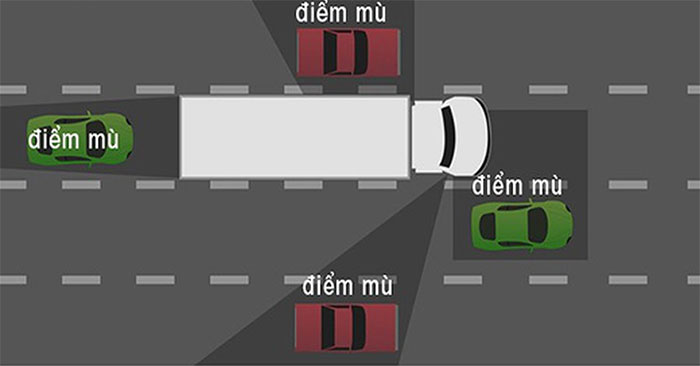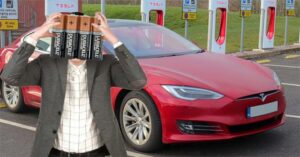
It is highly unsafe for motorbike and car drivers to enter the blind spot of trucks, leading to serious accidents. Learn how to stay safe in traffic.
What is a car’s blind spot?
The blind spot of a car refers to the portion of space that, even with the assistance of a rearview mirror, cannot be seen by the driver when they are seated in a normal driving position, without turning their head or leaning their body.

In simple terms, a blind spot refers to the space surrounding a vehicle (especially large trucks, tanker trucks, and container trucks) that is hidden from the driver’s view and cannot be seen.
When engaged in traffic, it can be incredibly unsafe if a car driver fails to notice the presence of a motorbike, scooter, or bicycle in their blind spot. Such lack of attention can easily lead to accidents and pose great danger for all involved.
Blind spots on cars
Blind spot in front of the car
The front design of a car creates a blind spot in front of it.
Pickup trucks and SUVs, due to their higher chassis, possess significantly larger blind spots in front of the vehicle compared to sedans and hatchbacks.
Blind spots located at the front of a vehicle can frequently present challenges and hazards while driving in congested areas, crossing bridges, maneuvering on steep slopes, and during reverse parking situations.
The car has a blind spot towards the rear.
The rear blind spot of a vehicle extends for several meters from the back, making it challenging to reverse, park, and turn. The size of this blind spot area increases with a higher vehicle chassis.
Rearview mirror blind spot
Rearview mirrors aid in observing the sides and rear of a vehicle, but their limited size and the vehicle’s structure make it challenging to have a complete view. As a result, certain areas remain unseen, forming blind spots in the rearview mirror.
Blind spots in car rearview mirrors pose a significant danger and are highly likely to result in accidents, particularly when performing actions such as changing lanes, altering direction, making U-turns, reversing, and parking.

Blind spot column A
The windshield is flanked by Pillar A, which is the first pillar on both sides. Although it is not overly spacious, it can still impede the driver’s sight. This can be hazardous while navigating corners, changing lanes, or altering directions.
How to fix car blind spots
Ensure that you are seated in the appropriate driving position.
In order to enhance visibility, it is essential for the driver to properly adjust their seat and assume the correct driving position. This not only promotes comfort but also facilitates easier and smoother driving.
Modify the position of the rearview mirror according to the specific circumstances.
Even though there are some limitations, rearview mirrors remain extremely helpful for observing while driving and reducing blind spots. In order to effectively eliminate blind spots, the driver must adjust the rearview mirror correctly based on the specific situation.
When driving under normal conditions, it is advisable to adjust the rearview mirror to a wider angle in order to enhance visibility of both sides of the vehicle. However, when reversing or parking, it is recommended to narrow the mirror’s direction so that it becomes easier to observe the rear corner and rear tires.
Install convex mirrors on the car
Spherical mirrors, also known as car convex mirrors, are installed on both sides of the car’s rearview mirrors to eliminate blind spots. These mirrors have a wider projection angle compared to flat mirrors, enabling drivers to have improved visibility, particularly in the area directly behind the vehicle.
Utilize reverse sensors in cars
The manufacturer has installed a reverse sensor on the car, which functions to detect nearby obstacles during the process of reversing and parking. This sensor helps overcome blind spots in the front, rear, and corners of the car by issuing a warning signal. As a result, the driver can reverse more easily and safely.
Utilize automotive cameras.
Rear-mounted car cameras are commonly installed to provide drivers with a clear view of the entire area behind the car, effectively eliminating blind spots. This allows for easier and safer reversing of the vehicle.
The car is equipped with various types of rear cameras that assist in eliminating blind spots. These include a 360-degree camera that offers a full view of the surroundings, a forward camera that provides visibility ahead of the car, and a side mirror camera for monitoring the area alongside the vehicle.
Utilize the blind spot warning system of the car.
The car blind spot warning system functions by utilizing electronic transmitters strategically placed around the vehicle. These transmitters detect and generate a warning signal when a vehicle approaches too closely from the side or rear of your car.
Presently, the most cutting-edge approach to addressing blind spots is increasingly being adopted in the design of new car models.
Proficient in navigating around blind spots of large vehicles.
To stay safe, refrain from driving into the blind spots of trucks and containers. Remember, if you can see the driver in the rearview mirror of the car, they can also see you. However, if you cannot see the driver, it means you might be in their vehicle’s blind spot, and it’s crucial to swiftly move out of that position.
Avoid passing immediately in the blind spot; instead, wait until you are certain that the driver ahead has acknowledged the signal to allow you to pass from your vehicle.


